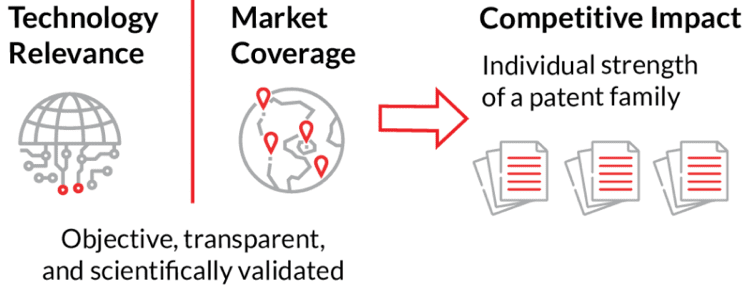Evaluate Patent Portfolios Based on Quantity and Quality

What is the best way to evaluate patent portfolios? Do you take the phrase literally and evaluate a portfolio based on the number of patents it contains, or is there a better way? The LexisNexis® PatentSight® innovation analytics platform offers multiple tools and patent metrics to help users gain a clear understanding of the sizes and strengths of patent portfolios maintained by companies all over the world.
Evaluate patent portfolios based on size alone
There are multiple pitfalls to using patent portfolio size as a performance metric. To begin, it is very difficult to grasp the actual size of a company’s patent portfolio using traditional patent search methods. Most patent databases only contain patent records specific to a limited geographical area, which means patent searchers often need to search many patent databases separately to obtain all of the international filings specific to a company. Additionally, because a company name may vary among its patent filings (e.g., “NewCo Corporation” vs. “NewCo Corp”) and also because companies often use subsidiaries to house their intellectual property, it is difficult for searchers to uncover all of the patents that are connected to a parent company using common keyword searches. PatentSight™ remedies these issues by providing users with access to patent records from over 56 patent authorities simultaneously, and by meticulously harmonizing patent data to make all of a company’s patent records accessible regardless of patent ownership naming discrepancies. Still, problems remain to evaluate patent portfolios by the number of patents they contain.
A bigger patent portfolio is not always better in the patent world, so it is important to avoid that assumption. For instance, the majority of patents in a large portfolio may have narrow claims or are otherwise unenforceable. In this case, the patent portfolio may contain only a few quality patents and could be relatively weak at large. What large patent portfolios may indicate, however, is that a company has sufficient resources to pay for the expenses associated with prosecuting multiple patent applications. They may also have a certain level of seriousness when it comes to protecting their inventions. Additional information is needed to truly evaluate patent portfolios.
Size and quality: a match made in PatentSight®
High-quality patents tend to be those that provide a significant advantage to the patent owner through their limited monopoly over the protected invention or by positioning them for lucrative patent licensing agreements or patent assignment opportunities. The value of an invention also tends to be tied to the scope of its patent protection as it relates to the global market. With this in mind, PatentSight calculates and presents to its users the Competitive Impact™ patent metric which can be used to effectively communicate the individual strength of patent families. Each Competitive Impact™ value uses a patent family’s scope of protection and the number of times it is cited in subsequent filings to determine its value relative to other patent families in a similar space. The size of patent portfolios may not tell us much on its own but viewing a portfolio’s size in conjunction with the Competitive Impact values of the patents it contains can help to determine the overall strength of a specific patent portfolio. PatentSight visualization tools can even reveal to users which portfolio patents stand out as being more valuable than the rest, and how many high-value patents a company possesses.

The best way to evaluate patent portfolios has less to do with quantity than it does with quality. The PatentSight analytics platform provides a variety of sophisticated tools that allow users to better understand a patent portfolio’s size and strengths. With global coverage, harmonized patent data, and advanced patent metrics, PatentSight is a quality patent solution for understanding both portfolio size and quality.
Learn more about PatentSight.
See how data inaccuracy in the applicant name field can result in costly and damaging repercussions to the business.
Explore how excellent data quality is the foundation of reliable analyses.
Learn how to transform patent data into intelligence and how to turn your search results into compelling visualizations.

Get actionable insights for strategic decision making
Want to become more effective at managing your patent portfolio, identify worldwide relevant patents and technology trends, assess the competitive landscape, and find partners and licensing opportunities?
